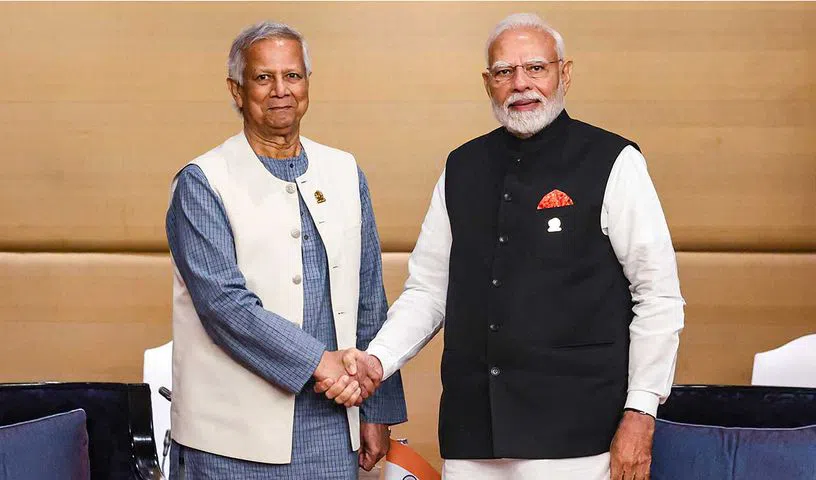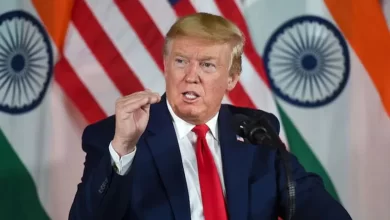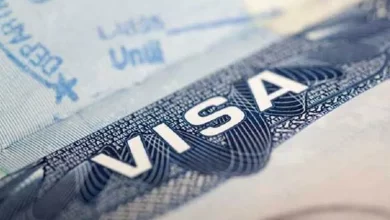
By inviting China to view Bangladesh as an extension of the Chinese economy, Yunus signalled a willingness to align more closely with Beijing
By Geetartha Pathak
Bangladesh’s interim government’s Chief Adviser Muhammad Yunus’ four-day visit to China during the last week of March drew significant attention due to its geopolitical implications, particularly his remarks on Northeast India.
Yunus had said that the geographical disadvantage of Northeast India is a “huge opportunity” for China to extend its economic reach into India’s Northeast, Nepal and Bhutan via Bangladesh’s ports, such as Chattogram, Mongla, Payra and the under-construction Matabari. His statements underscored Bangladesh’s shifting foreign policy dynamics and raised concerns in India about regional security and strategic vulnerabilities.
Chicken’s Neck
The Siliguri Corridor, also known as the Chicken’s Neck, is a narrow strip of land in West Bengal, approximately 22 kilometres wide at its narrowest point, connecting India’s Northeastern States to the rest of the country. Bordered by Nepal, Bhutan and Bangladesh, with China’s Chumbi Valley nearby, it is a critical lifeline for India, facilitating trade, military logistics and connectivity to a region of over 5 crore people.
Yunus’ remarks on the Siliguri Corridor triggered sharp reactions in India. Assam Chief Minister Himanta Biswa Sarma called them “offensive and strongly condemnable,” arguing that they reinforced the “persistent vulnerability narrative” surrounding the corridor. Sarma urged New Delhi to bolster railway infrastructure and road networks around the Chicken’s Neck and explore alternative routes to connect the Northeast to mainland India, bypassing the corridor’s stranglehold.
However, there is no other alternative to connect Northeast securely with the rest of India except through the Bangladesh route. Yunus’ comments during a high-level roundtable on sustainable infrastructure and energy in Beijing signalled a deliberate pitch to integrate Bangladesh more closely with China’s economic framework.
Chinese Embrace
Yunus met Chinese President Xi Jinping and signed nine agreements aimed at deepening economic ties between Bangladesh and China during the visit. He urged Beijing to expand its economic influence in Bangladesh, emphasising the country’s strategic location.
His reference to the ‘Seven Sisters’ — as landlocked, with no direct access to the ocean indicated Bangladesh’s shifting foreign policy. His comments highlighted the corridor’s vulnerability, implying that Bangladesh could serve as an alternative maritime gateway for the Northeast, potentially reducing India’s control over its own region’s access to global trade routes. The development alarmed ruling as well as opposition Indian leaders, as it suggested a strategic opening for China to encircle India’s Northeast, leveraging Bangladesh as a conduit.
The importance of Yunus’ visit lies in its timing and context. Bangladesh, under his interim leadership following the ouster of Sheikh Hasina in August 2024, is navigating a political and economic crisis. Yunus sought Chinese investments, loans and grants — securing commitments worth $2.1 billion — to revive the country’s flagging economy.
His outreach to China, a major lender to Bangladesh with $7.5 billion in loans, reflects a pivot away from India, which had been a close partner under Hasina. By inviting China to view Bangladesh as an “extension of the Chinese economy,” Yunus signalled a willingness to align more closely with Beijing, potentially at India’s expense.
Strategically, Yunus’s comments touch on India’s long-standing fears of encirclement by China, especially given Beijing’s growing presence in South Asia — seen in Sri Lanka’s Hambantota Port and infrastructure projects in Myanmar and Nepal. A stronger Chinese foothold in Bangladesh, particularly near the Siliguri Corridor, could endanger India’s defence posture, as a Chinese advance of just 130 km from the Chumbi Valley could sever the Northeast from the mainland.
Yunus’ Press Secretary Shafiqul Alam had told reporters that Yunus desired to travel to India before visiting China, but Dhaka’s request for the visit did not elicit a “positive” response from India. However, later, Modi and Yunus met on the sidelines of the 6th BIMSTEC Summit in Thailand on April 4. The much-awaited meeting lasted 40 minutes, according to media reports.
A stronger Chinese foothold in Bangladesh, particularly near the Siliguri Corridor, could endanger India’s defence posture, as a Chinese advance of just 130 km from Chumbi Valley could sever the Northeast from the mainland
Bangladesh’s leading English daily The Daily Star reported – “some of the issues that irritate Bangladesh, including the long-pending Teesta water sharing deal, the renewal of the Ganges water treaty and border killing were raised by Yunus in the meeting. Modi reiterated India’s support for a “democratic, stable, peaceful, progressive and inclusive Bangladesh” and highlighted that cooperation between the two countries has brought tangible benefits to the people of both countries and underlined India’s desire to forge a positive and constructive relationship with Bangladesh based on pragmatism.
Proactive Diplomacy
The relationship between the two countries has faced strain since the ouster of Sheikh Hasina, followed by the establishment of an interim government under Muhammad Yunus in Bangladesh. This transition has exposed underlying tensions, including anti-India sentiment, border issues and differing geopolitical priorities. However, the deep historical, cultural and economic ties between the two nations provide a foundation for reconciliation.
India must take the initiative in rebuilding the trust between the two countries, not only for the sake of its strategic security but also for mutual economic and social prosperity. India should continue proactive diplomacy. Foreign Secretary Vikram Misri’s visit to Dhaka in December was a good gesture. Regular interactions between Indian and Bangladeshi leaders, including potential visits by Prime Minister Narendra Modi or External Affairs Minister S Jaishankar, could signal commitment to resetting ties.
Acknowledging Bangladesh’s sovereignty while addressing mutual concerns can rebuild trust. India’s concerns about attacks on Hindus in Bangladesh should be raised diplomatically, backed by evidence, while respecting Bangladesh’s assurances of protecting all communities.
Establishing a joint media monitoring and fact-checking mechanism to counter misinformation, as suggested by Bangladesh’s interim government, inviting Indian journalists for on-ground reporting, may improve the situation. This could mitigate exaggerated narratives about minority safety or India’s role in Bangladesh’s politics. Encouraging informal dialogues between academics, business leaders and civil society from both countries to foster mutual understanding and provide policy recommendations is another way of resolving the differences.
Resuming technical-level talks to resolve the Teesta River water-sharing issue and the renewal of the 1996 Ganga Water Treaty, due in 2026, should be prioritised. India must move beyond its historical reliance on the Awami League and build ties with a broader spectrum of Bangladeshi stakeholders.
Bangladesh, in turn, should recognise the mutual benefits of a stable partnership with India, especially given their geographical proximity and economic interdependence. By addressing immediate issues like water disputes and border issues, while investing in long-term economic and cultural ties, both nations can navigate the current turbulence and restore their relationship to a constructive path.







